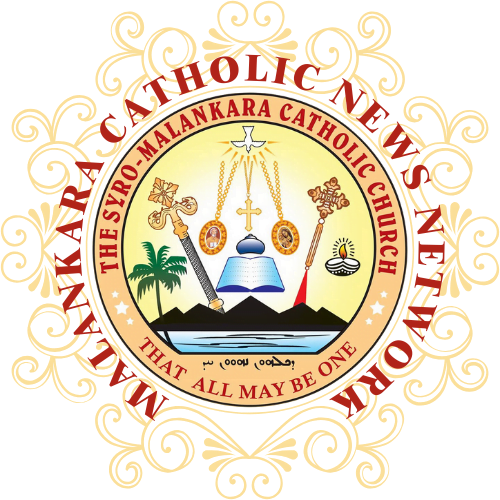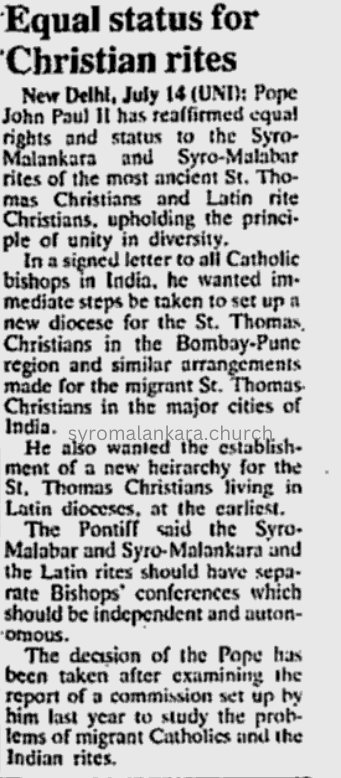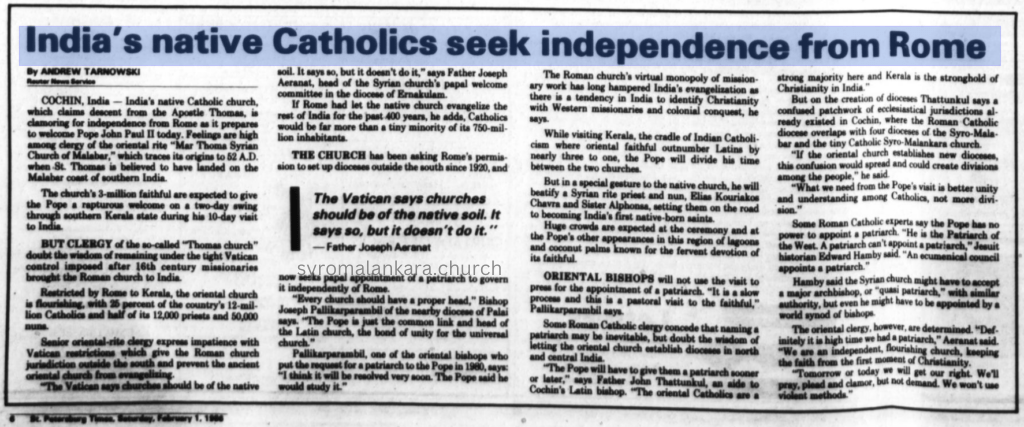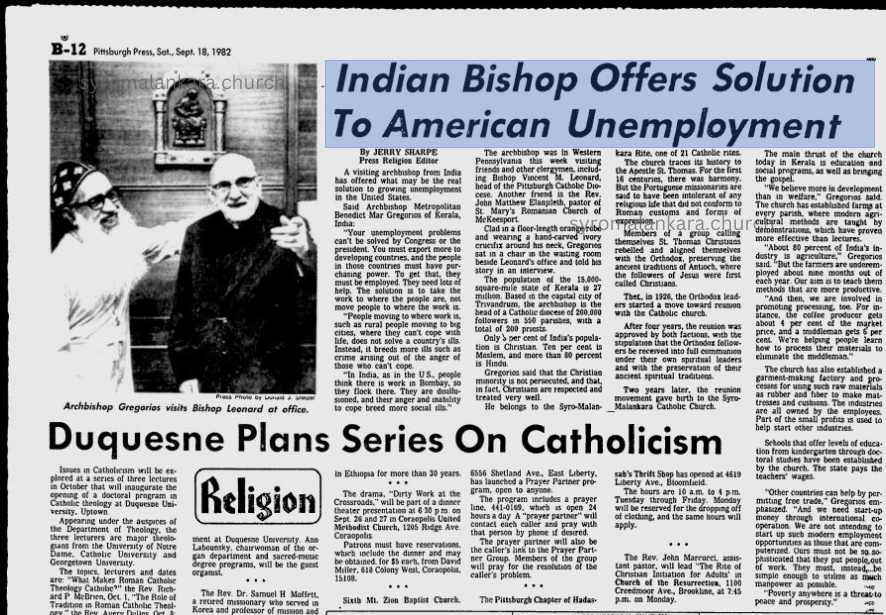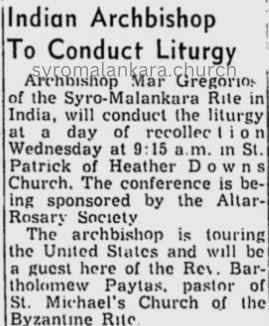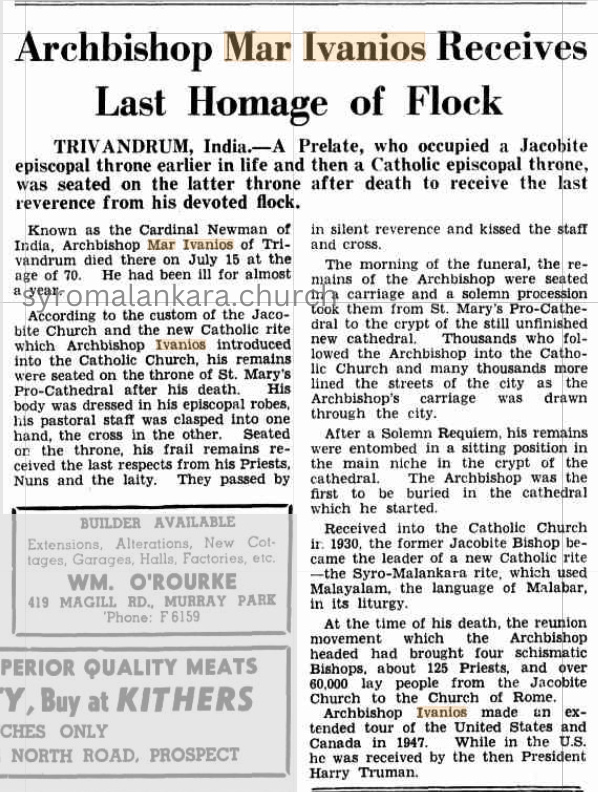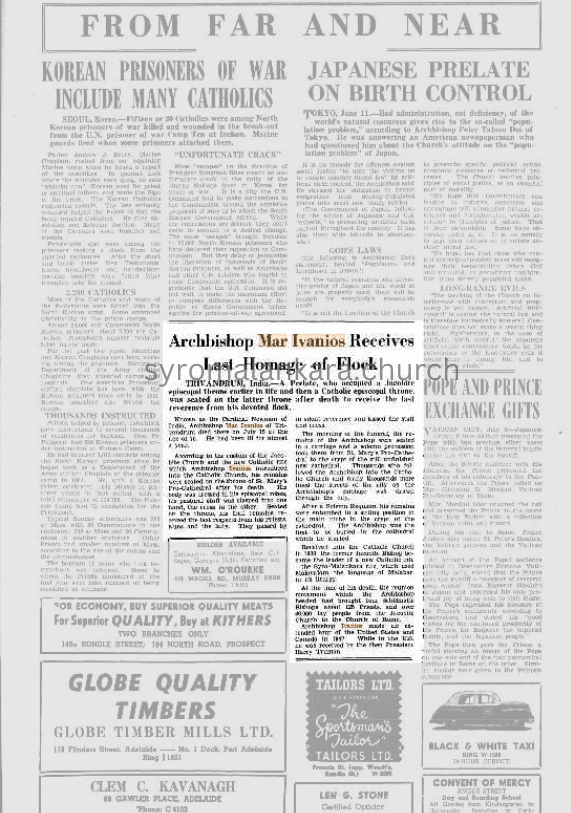Trivandrum (India)
Saturday, 8 February 1986
Dearly Beloved in Christ,
1. My pilgrim steps have brought me to Trivandrum!
To you, my brothers and sisters of this part of Kerala, I repeat the greeting of the Apostle Paul: “Grace to you and peace from God our Father and the Lord Jesus Christ” . Grace and peace: great gifts of God’s love which satisfy deep yearnings of our human hearts!
On the road from the airport I have been able to visit the Cathedral of Saint Joseph and the Cathedral of Saint Mary. These visits have a particular symbolism. They express the fullness of ecclesial communion and peace between us: between the Successor of Peter and your local Churches, the Latin Dioceses of Trivandrum Quilon and Punalur and the Syro-Malankara Metropolitan See of Trivandrum.
In this spirit of unity in the Mystical Body of Christ I cordially greet my brother bishops, the priests, the men and women religious, and the faithful of all the dioceses represented here. As we raise our hearts and minds to Almighty God – Father, Son and Holy Spirit – may we experience deep joy in our solidarity as disciples of our Lord and Saviour Jesus Christ!
To the distinguished civil authorities and representatives of the various Christian Churches and to our brothers and sisters of other religious traditions I express my warm sentiments of respect and esteem.
2. At this stage of my pilgrimage through India I wish to avail myself of this visit to Trivandrum to address a particular word of affection to the Syro-Malankara Church of which Trivandrum is the principal See, under the guidance of Archbishop Mar Gregorios.
Your Church, beloved brothers and sisters, traces its origin to the Apostle Saint Thomas. You possess a very ancient liturgical tradition which had its origin in Antioch, where the followers of Jesus were first called “Christians” . For more than sixteen centuries our community remained in unbroken communion with the See of Peter. Then there was a series of difficulties which interrupted that communion. But this century has been indelibly marked by the luminous figure of Archbishop Mar Ivanios, who found wisdom and sensitivity to the cause of Christian unity in my predecessor Pius XI, to whom he made an historic visit in 1932.
I am very pleased to know that the latest period of your Church’s history has been a time of growth and vigorous Christian life. The establishment of the Major Seminary dedicated to Mary, Mother of the Church, is a sign of your vitality. It offers great hope of further strength and consolidation in the future.
In 1980 I had the great pleasure of sending Cardinal Rubin as my personal representative to the Jubilee celebrations. And today I have been given the grace to visit you personally. Today I wish to encourage you in your faith, in your fidelity to your ancient traditions, in your sincere efforts to promote fraternal relations with your brothers and sisters of the Jacobite and Orthodox Churches and other Ecclesial Communions. May your constant aspiration be that the time will soon come when the prayer of our Lord for perfect unity among all his disciples will be realised , so that the Church in every place and in every age may shine forth as “a people made one with the unity of the Father, the Son and the Holy Spirit” .
3. To Bishop Jacob and to all the priests, religious and laity of the Latin Diocese of Trivandrum I express fraternal love in our Lord Jesus Christ.
I commend to the loving intercession of our Blessed Mother the life of your parishes, your schools and colleges and the charitable and pastoral organisations which contribute greatly to your diocesan life. As the humble servant of the Lord , Mary stands before you as the perfect model of your daily service to the ecclesial and civil communities in which you proclaim the Gospel message of life and give effective witness to the evangelical law of love . Today the Successor of Peter is very happy to be in your midst. I pray that my visit will comfort you and encourage you.
4. Brothers and sisters in Christ: as Christians we are sent to serve. Christ himself said: “I am among you as one who serves” . Service is a path which is most clearly exemplified in the life and ministry of Jesus. Along this path we too must walk. The infant in the manger at Bethlehem, the child lost in the Temple, the carpenter of Nazareth, the teacher sitting by the well at Sychar , the Master who washes the disciples’ feet , the Son of Man who lays down his life for his friends – these are some of the images of God’s love for man at work through Jesus in the affairs of human history.
In the solemn words of Saint Paul, Jesus Christ “though he was in the form of God, did not count equality with God a thing to be grasped, but emptied himself, taking the form of a servant, being born in the likeness of men” .
The Church too is called upon reproduce in her life and ministry the model of Jesus’ service. Like him the Church must act in a spirit of service to the human family. For her, to serve the human family is to serve Christ her Lord.
In this sense certain expressions of the Second Vatican Council are a constant challenge to us: “the Church encompasses with love all those who are afflicted with human weakness… She recognises in the poor and the suffering the likeness of her poor and suffering Founder. She does all she can to relieve their need and in them she strives to serve Christ” .
Has this not been the experience of the Saints in every time and place? Is this not the example left to you by a multitude of men and women who have witnessed to Christ in this region of Kerala? Is this not the work of your parishes and institutions today? Are not many of you personally engaged in many forms of service to your needy brothers and sisters, without seeking earthly profit or advantage?
5. The Church here, and throughout India, is a servant Church. She sees her poor and suffering Founder in the faces of all those, young or old, who are victims of poverty in any of its forms: hunger and malnutrition, unacceptable living conditions, disease, illiteracy, injustices at work and in society, the privation of fundamental freedoms, discrimination because of race, religion, sex, community or language.
In this Messianic Kingdom of Christ the poor and the suffering have a special place. Indeed, the Kingdom belongs to them: “Blessed are you poor, for yours is the kingdom of God” . The signs of the presence of God’s Kingdom are the preaching of the Good News to the poor, the proclaiming of sight by the blind, the setting free of those who are oppressed, the proclamation of the acceptable year of the Lord . All these mean that the Church’s service to the Kingdom of God is accomplished in her service to the poor and to the suffering.
The Church excludes no one from her compassion and loving service. Like a good mother she loves all: children, youth, the aged, the workers, the homeless, the hungry, the handicapped, the spiritually deprived, and those who recognise their sinfulness and so experience through her the healing touch of Christ. To everyone, but to the poor in particular, the Church offers the Good News of man’s human and supernatural dignity. In Christ, man has been elevated to the state of divine sonship. He is a child of God, called to live in dignity in this world and destined for eternal life.
The Church is the home of the poor and the rich alike, for “God shows no partiality”. However, each community in the Church is required to make a special effort so that the poor feel fully at home in her. For this reason the Church herself, “in humility and self-sacrifice” , must be willing to walk the paths of the dispossessed and those who seek after justice. In this way she walks in the footsteps of her Lord, who “emptied himself, taking the form of a servant”.
6. Twenty years ago the Second Vatican Council clearly recognised that “we are at a moment in history when the development of economic life could diminish social inequalities if that development were guided and coordinated in a reasonable and human way”. But at the same time the Council fore saw – and rightly – that material development too often serves only to intensify such inequalities. What is needed for greater social justice is this: that economic development and the technical instruments it produces should be placed at the service of man: at the service of the whole man, and of every man – every man, woman and child – without intolerable forms of discrimination. In his social Encyclical “Mater et Magistra“, Pope John XXIII vindicated a principle which is entirely valid today: “Economic progress must be accompanied by a corresponding social progress, so that all classes of citizens can participate in the increased productivity.
Furthermore, economic and social progress must be directed to the integral well-being of the human person. This means that people must not be considered as mere instruments of production. They must be treated in accordance with their human dignity and in accordance with their needs, which are not material but also cultural and spiritual.
India understands the spiritual nature of the human person. Your culture causes you to be sensitive to the transcendental values that are an inseparable part of human activity and all relationships. The world is faced by this challenge: development must be truly harmonised with the promotion of the spiritual dignity of individuals and their inalienable rights. You possess an ancient wisdom which claims that it is not just material progress which benefits a people and a nation, but rather the resulting social peace and freedom, including freedom of conscience and religion.
7. Brothers and sisters of the Catholic Church: as citizens of your country you have the right and duty to contribute to the progress of the civil society to which you belong. I encourage you to do this in a spirit of service, in the spirit of Christ who taught us the fullest meaning of love. As Saint John says: “By this we know love, that he laid down his life for us; and we ought to lay down our lives for the brethren. But if any one has the world’s goods and sees his brother in need, yet closes his heart against him, how does God’s love abide in him? Little children, let us not love in word or speech, but in deed and in truth”.
In co-operation with all people of good will, the local Churches have a vital part to play in relieving hardship and suffering. Much can be done, as the Council says, “to help people gain a sharper insight into their full destiny, so that they can fashion the world more to man’s surpassing dignity, search for a brotherhood which is universal and more deeply rooted, and meet the urgencies of our age with a gallant and unified effort born of love”. As far as possible, educational activities should be intensified in order to enable the younger generation to face the realities of life with courage and to take a responsible part in working to improve them. The Church also has a special duty to support the holiness of family life, essential for the well-being of individuals and of society.
By working for the common good, which includes both the material and spiritual welfare of all sectors of the population, the Church fulfils her servant role. In all your efforts I commend you to the Blessed Virgin Mary and to Saint Joseph, to whom the Cathedrals of Trivandrum are dedicated. Mary and Joseph encouraged Jesus to serve. By their prayers and example they do the same for us today.
Brothers and sisters: “Whatever you do, in word or deed, do everything in the name of the Lord Jesus Christ”.
© Copyright 1986 – Libreria Editrice Vaticana
